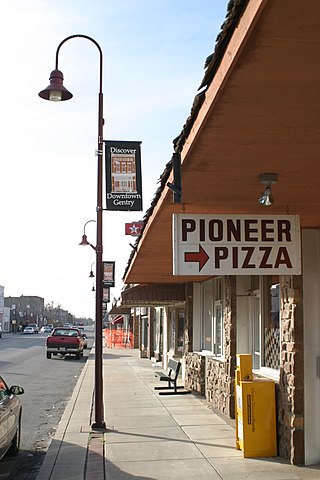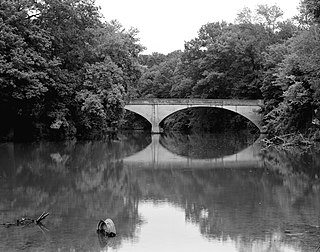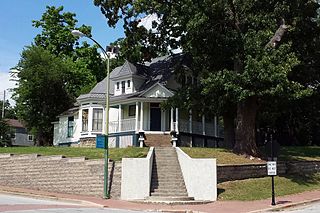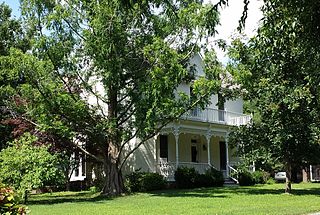
Benton County is a county within the Northwest Arkansas region with a culture, economy, and history that have transitioned from rural and agricultural to suburban and white collar since the growth of Walmart, which is headquartered in Benton County. Created as Arkansas's 35th county on September 30, 1836, Benton County contains thirteen incorporated municipalities, including Bentonville, the county seat, and Rogers, the most populous city. The county was named after Thomas Hart Benton, a U.S. Senator from Missouri influential in Arkansas statehood.

Gentry is a city in Benton County, Arkansas, United States. The population was 3,790 as of the 2020 census. The city was founded in the Ozark Mountains in 1894 along what would become the Kansas City Southern Railroad. The city's prior prosperity in the orchard industry, especially apples, was further strengthened by the rail connection. Following the decline of the apple industry in the 1930s, Gentry shifted its economy towards poultry along with many other areas of Northwest Arkansas.

Siloam Springs is a city in Benton County, Arkansas, United States, and located on the western edge of the Northwest Arkansas metropolitan area. As of the 2020 census, the population of the city was 17,287. The community was founded in 1882 and was characterized by the purported healing powers of the spring water feeding Sager Creek and trading with nearby Native American tribes. The city shares a border on the Arkansas–Oklahoma state line with the city of West Siloam Springs, Oklahoma, which is within the Cherokee Nation territory. It is home of John Brown University.

Jobbers Canyon Historic District was a large industrial and warehouse area comprising 24 buildings located in downtown Omaha, Nebraska, US. It was roughly bound by Farnam Street on the north, South Eighth Street on the east, Jackson Street on the south, and South Tenth Street on the west. In 1989, all 24 buildings in Jobbers Canyon were demolished, representing the largest National Register historic district loss to date.

The Illinois River Bridge is a historic bridge, carrying a discontinued portion of Kincheloe Road over the Illinois River northeast of the hamlet of Pedro, Arkansas. It is a single-span Pratt through truss with a span of 126 feet (38 m) and a total structure length of 206 feet (63 m). The bridge was built by the county in 1922, and was closed to traffic in 2004.
Harrington House may refer to:

The Illinois River Bridge, also known as the Midway Bridge, is a historic concrete arch bridge near Siloam Springs, Arkansas. It is located in Ozark National Forest, about 6 miles (9.7 km) east of Siloam Springs, at the end of Chambers Springs Road south of United States Route 412. The bridge has two elliptical arch spans, each spanning 68 feet (21 m), with a total structure length of 139 feet (42 m). Built in 1922 by the Luten Bridge Company of Knoxville, Tennessee, it is one of a modest number of bridges of this once-popular and common type remaining in the state.

The Alfrey-Brown House is a historic house located at 1001 South Washington Street in Siloam Springs, Arkansas, United States.

The Bratt-Smiley House is a historic house at University Street and Broadway in Siloam Springs, Arkansas.

The Camp Crowder Gymnasium is a historic school building at 205 Shiloh Drive in Sulphur Springs, Benton County, Arkansas. It is primarily a building with local significance, and also is a rare example of military construction in the small community.

The Duckworth-Williams House is a historic house at 103 South College Street in Siloam Springs, Arkansas. It is a two-story stuccoed brick building, with a side gable roof that has a wide shed-roof dormer on the front. The roof extends across the front porch, which is supported by four stuccoed brick columns. The side walls of the house have half-timbered stucco finish. Built c. 1910, this is the only Tudor Revival house in Siloam Springs.

The First National Bank is a historic commercial building at 109 East University Street in Siloam Springs, Arkansas. It is a two-story brick building, trimmed in stone. Its ground floor is recessed in an arcade supported by square posts, and is separated from the second floor by a stone belt course. The upper floor windows have round stone arches, with two narrow bays projecting slightly. The cornice has corbelled brickwork, and is topped in a few places by stone caps. The building is Siloam Springs' only significant example of Romanesque Revival architecture.

The German Builder's House is a historic house at 315 East Central Street in Siloam Springs, Arkansas. It is a two-story brick I-house, with a side gable roof and a rear wood-frame addition, giving it an overall T shape. A porch with open veranda above spans most of the width of the main facade, with Queen Anne style turned posts and balusters, and a spindled frieze. The house was built c. 1880 by German masons from St. Louis who were working on a nearby school building. It is one of the finest brick I-houses in Benton County.

The Henry Furniture Store Building is a historic commercial building at 107 West University in Siloam Springs, Arkansas. It is a single-story brick building, with an angled recessed storefront topped by a raised brick parapet set above brick corbelling and a pressed metal cornice. Built c. 1900, it is the best example in the city of commercial architecture from that time period.

The Crown Hotel, formerly the Lakeside Hotel is a historic hotel building at 119 West University Street in Siloam Springs, Arkansas. It is a two-story brick building in an L shape, with a hip roof topped by a low cupola. It is distinguished by the brickwork at the roofline, and by the delicately spindled two-story porch that wraps around two sides of the building. Built in 1881, just one year after the city's founding, it is one of the city's oldest commercial buildings, and may have been its first brick hotel.

The Simon Sager Cabin is a historic log cabin on the campus of John Brown University in Siloam Springs, Arkansas. It is the oldest permanent structure in Siloam Springs. The cabin was listed on the National Register of Historic Places in 1976.

The Shiloh House is a historic house at 700 Lodge Dr. in Sulphur Springs, Benton County, Arkansas. Built in 1927, it is one of the largest examples of Bungalow and Craftsman-style architecture in Benton County.

Siloam Springs City Park is a triangular city park in the center of Siloam Springs, Arkansas. Established c. 1897, it is bounded on the north by West University Street, the east by South Mount Olive Street, and roughly on the west by Sager Creek. The creek and two springs are the park's principal natural features; the springs are believed to be those that gave the city its name, and are now located in a sunken concrete basin with fieldstone walls. The park also has a c. 1897 Queen Anne style gazebo and a footbridge across the creek just above a low stone dam. The West University Street bridge, built in 1911, has distinctive handrails with embedded light fixtures.

The Siloam Springs Downtown Historic District encompasses the historic downtown area of Siloam Springs, Arkansas. The district is roughly bounded by University Street, Broadway, and Sager Creek, with a few buildings on adjacent streets outside this triangular area. This business district was developed mainly between about 1896, when the railroad arrived, and 1940, and contains a significant number of buildings dating to that period. It also includes Siloam Springs City Park, the location of the springs that gave the city its name. Notable buildings include the First National Bank building, a c. 1890 Romanesque Revival building, and the c. 1881 Lakeside Hotel, which is one of the city's oldest commercial buildings.

The Stockton Building is a historic commercial building at 113 North Broadway in downtown Siloam Springs, Arkansas. It is a two-story masonry structure with a pressed metal cornice that is horizontal at the outer bays and with a gabled pediment at the center. Built in 1894, it is a distinctive yet vernacular example of late 19th-century commercial architecture, unique in the city.





















